Podcast
Questions and Answers
Explain how creating mismatches or errors during a task can trigger neuroplasticity. What makes the brain start changing?
Explain how creating mismatches or errors during a task can trigger neuroplasticity. What makes the brain start changing?
Errors signal the brain that something is wrong, which prompts the release of neurochemicals that drive change.
Besides motor skills and balance, how can focusing on motor and vestibular programs lead to more general brain changes?
Besides motor skills and balance, how can focusing on motor and vestibular programs lead to more general brain changes?
Focusing on motor and vestibular programs can create conditions in the brain that facilitate learning in other areas.
Describe how wearing prism glasses demonstrates the concept of shifting aligned maps within the nervous system, and note how this ability changes with age.
Describe how wearing prism glasses demonstrates the concept of shifting aligned maps within the nervous system, and note how this ability changes with age.
Prism glasses shift the visual field, causing initial errors. Young people adjust their motor behavior quickly, while older individuals often struggle, showing a difference in adult plasticity.
Why is incremental learning particularly important for adults regarding neuroplasticity?
Why is incremental learning particularly important for adults regarding neuroplasticity?
How can attaching dopamine to the process of making errors enhance the rate of learning and plasticity?
How can attaching dopamine to the process of making errors enhance the rate of learning and plasticity?
Explain the concept of 'limbic friction.' How does understanding this concept relate to optimizing conditions for neuroplasticity?
Explain the concept of 'limbic friction.' How does understanding this concept relate to optimizing conditions for neuroplasticity?
Describe the role of the vestibular system in heightened or accelerated plasticity and what three planes of movement are involved?
Describe the role of the vestibular system in heightened or accelerated plasticity and what three planes of movement are involved?
How can you trick your autonomic nervous system into waking up or becoming more alert?
How can you trick your autonomic nervous system into waking up or becoming more alert?
What practical steps can be taken before learning something to ensure an appropriate state of autonomic arousal that will facilitate plasticity?
What practical steps can be taken before learning something to ensure an appropriate state of autonomic arousal that will facilitate plasticity?
What is the role of the cerebellum in initiating the release of dopamine, norepinephrine, and acetylcholine and why does this matter for neuroplasticity?
What is the role of the cerebellum in initiating the release of dopamine, norepinephrine, and acetylcholine and why does this matter for neuroplasticity?
Flashcards
Representational Plasticity
Representational Plasticity
The nervous system's ability to remap its internal representation of the external world, triggered by errors.
Neurochemicals for Brain Change
Neurochemicals for Brain Change
Neurochemicals like acetylcholine, epinephrine, and dopamine are needed to mark neural circuits for change.
Motor & Vestibular Programs
Motor & Vestibular Programs
Focusing on motor and vestibular programs can facilitate broader brain changes, aiding learning in other areas.
Errors as Signals
Errors as Signals
Signup and view all the flashcards
Incremental Learning
Incremental Learning
Signup and view all the flashcards
Ultradian Rhythms
Ultradian Rhythms
Signup and view all the flashcards
Dopamine and Error-Making
Dopamine and Error-Making
Signup and view all the flashcards
Limbic Friction
Limbic Friction
Signup and view all the flashcards
Vestibular System's Role
Vestibular System's Role
Signup and view all the flashcards
Components For Plasticity
Components For Plasticity
Signup and view all the flashcards
Study Notes
Overview of Nervous System Change
- The nervous system includes the brain, spinal cord, and connections to organs.
- The nervous system dictates behavior, emotions, and perceptions.
- Humans can change their nervous systems through deliberate actions, especially those involving movement and balance.
- Motor commands and balance provide pathways for influencing the nervous system, even for changes unrelated to movement.
Representational Plasticity and Error Correction
- Representational plasticity refers to the internal mapping of the external world.
- Creating mismatches or errors during performance triggers neuroplasticity.
- Errors signal the brain that something is wrong, prompting the release of neurochemicals that drive change.
Neurochemicals and Brain Change
- Brain change requires specific neurochemicals: acetylcholine, epinephrine, and dopamine.
- These chemicals mark neural circuits for change, with actual changes occurring during sleep.
- Focus helps release these chemicals, but making errors is critical for triggering dopamine release.
Focus on Motor and Vestibular Programs
- Motor and vestibular programs can set the stage for broader brain changes beyond just motor skills and balance.
- Focus on these programs can create conditions in the brain that facilitate learning in other areas.
Plasticity in Development and Adulthood
- The brain is highly plastic from birth to about age 25.
- Plasticity tapers off after age 25, requiring different methods to engage it.
- Auditory, visual, and motor maps are aligned, allowing fluid movement through space.
- These maps can shift through neuroplasticity, as shown in experiments with prism glasses.
Prism Glasses Experiments
- Wearing prism glasses shifts the visual field, causing initial errors in reaching for objects.
- Young people quickly adjust their motor behavior to reach correctly despite the visual shift.
- This indicates the ability to shift aligned maps within the nervous system.
- Older individuals often struggle to make this shift, highlighting differences in adult plasticity.
Errors as Signals for Plasticity
- Making errors signals the nervous system to initiate changes, crucial for neuroplasticity and learning.
- Frustration from errors can be leveraged to drive deeper engagement and plasticity.
- Errors lead to the release of epinephrine (alertness) and acetylcholine (focus), helping to correct performance.
- Dopamine is released when performance starts to approximate the correct behavior, allowing plastic changes to occur rapidly.
Incremental Learning and High-Stakes Contingency
- Incremental learning is essential for adults due to the need for smaller error margins; smaller bouts of learning are the key.
- Massive plasticity in adults can occur under high-stakes conditions, like needing to find food.
- High contingency emphasizes that the importance of a task or goal accelerates and magnifies plasticity.
- These conditions point to the release of chemicals from internal stores within the brain.
Ultradian Rhythms and Learning
- Ultradian rhythms involve 90-minute cycles that affect focus and learning.
- Initial minutes of learning may involve mind drift, but focus should kick in.
- An hour of focused learning can be followed by a period of frustration and errors, which is crucial for triggering chemical cues for plasticity.
- Rest after intense learning allows for consolidation and improved performance later.
Attaching Dopamine to Error-Making
- Attaching dopamine to the process of making errors combines modes of plasticity, accelerating the rate of learning.
- This means telling oneself that failures are beneficial enhances the rate of plasticity
- Dopamine can be released subjectively, based on what we believe is good for us.
- Making errors and associating them with positive learning goals can significantly enhance learning outcomes.
Frequency and Timing
- It is important to find ideal times throughout the day to engage in error-making and learning.
- The episode stresses the importance of focus when committing errors.
Optimal Learning Time
- The best time to learn varies for each individual, depending on sleep patterns and natural biological rhythms.
- Identify the times of day when your mental acuity is highest for optimal learning.
- Learning should involve making errors and pushing through them for 7-30 minutes.
- Seeking frustration during learning can create an optimal neurochemical environment for learning.
- This state enhances learning for other subjects for about an hour afterward.
Neuroplasticity Mechanisms
- Balance via the vestibular system and limbic friction (autonomic arousal) are key for opening up neuroplasticity.
Limbic Friction Explained
- Limbic friction describes when the autonomic nervous system isn't where one wants it.
- It captures information in neurobiology and psychology textbooks and carries implications for neuroplasticity.
- It is a more nuanced term than "stress," which often evokes negative connotations like rapid heartbeat and sweating.
- Limbic friction occurs both when trying to calm down from being too alert and when trying to become more alert from fatigue.
- Accessing neuroplasticity requires focus and subjective reward attachment, often hindered by overall state.
Managing Alertness for Learning
- If too anxious, calming techniques involve the double inhale-exhale to offload carbon dioxide.
- This involves inhaling twice through the nose and exhaling once through the mouth.
- Panoramic vision (dilating field of gaze) can also reduce alertness.
- If too tired, prioritize a good night's sleep or Non-Sleep Deep Rest (NSDR) protocols.
- Super oxygenation breathing (inhaling more than exhaling) can also increase alertness.
- You can trick your nervous system into waking up by bringing more oxygen in by making your inhales deeper and longer
Assessing Limbic Friction
- Before learning, assess your limbic friction level: Are you too alert or too calm?
- Adjust arousal levels to reach the optimal state for learning.
Vestibular System and Balance
- The vestibular system (hardwired balance system) plays a key role in heightened or accelerated plasticity.
- The brain relies on propri accepted feedback from three planes of movement to understand where the body is.
- The three planes are pitch (nodding), yaw (shaking head no), and roll (side-to-side).
Ears and Balance
- The ears serve two main purposes, one is to hear right to perceive sound waves or take in sound waves for perception soall hearing.
- Sitting in our ears are these semicircular canals where little Stones roll back and forth and it sends signlas to the rest of our brain.
Cerebellum's Role
- Errors in vestibular motor sensory experience cause the cerebellum (mini brain) to signal deeper brain centers.
- These signals trigger the release of dopamine, norepinephrine, and acetylcholine.
- This process is designed to recalibrate motor movements relative to gravity, essential for survival.
- These circuits tap into chemical pathways that act as gateways to plasticity.
Key Components for Plasticity
- Ensure appropriate autonomic arousal before learning (clear, calm, focused, or slightly heightened).
- Intentionally make errors during the learning process.
- Engage the vestibular motor sensory relationship.
- Establish a high contingency by setting an important reason for learning.
Movement and Plasticity
- Children exhibit more diverse movements than adults, potentially contributing to greater plasticity.
- Reduced plasticity in older individuals may be linked to more linear and regular movement patterns.
- The vestibular system amplifies plasticity by tapping into an inborn mechanism.
- The cerebellum has outputs to brain nuclei associated with dopamine, acetylcholine, and norepinephrine.
Practical Considerations
- Increased plasticity (enhanced learning) occurs if you really need to learn it.
- While mechanisms can enhance learning, there are limits to how quickly information can be absorbed.
Podcast Goals
- The podcast aims to provide insights into the mechanisms and biology underlying learning.
- It seeks to tailor foundational mechanisms to individual learning needs.
- The archival ensures accessible long term.
Studying That Suits You
Use AI to generate personalized quizzes and flashcards to suit your learning preferences.




